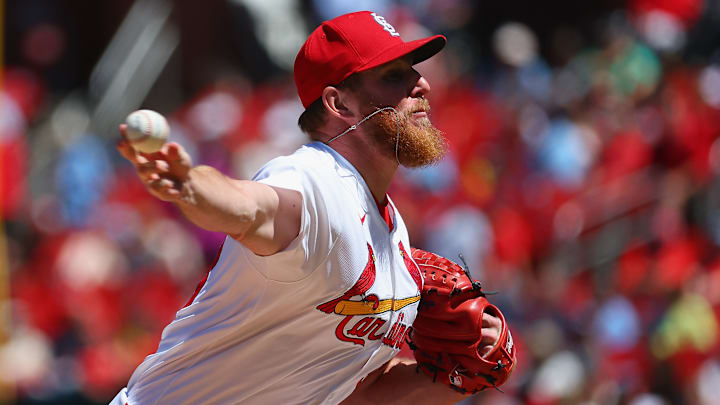Baseball teams are always looking for ways to gain an edge on the competition, and since the advent of Statcast in 2015, the race to find the next big analytical stat has only intensified. In 2021, the pitching stat of "Stuff+" was introduced to the public. Put simply, the statistic analyzes the movement, velocity and spin of a pitch, determines how effective pitches with similar attributes perform across the sport, and assigns a number to the pitch based on that effectiveness.
The most successful pitchers reliably possess the best Stuff+ metrics, and a key tenet to Stuff+ is that high velocity is beneficial. Indeed, velocity was the name of the game for the St. Louis Cardinals' bullpen in 2025. While the rotation was composed of soft-tossers, the Cardinals' arm barn held the second-highest fastball velocity in the major leagues. Ryan Helsley, who was traded to the New York Mets at the deadline and subsequently imploded, was a major factor in that number, and it contributed to his well-above-average 129 Stuff+ stat with the Cardinals in 2025.
Although Helsley has departed, there are a few other pitchers in the Cardinals system who have flashed promising Stuff+ metrics with their fastballs. Geoff Pontes of Baseball America wrote an article (subscription required) on Oct. 1 that listed the top four-seam and two-seam (sinking) fastballs among minor league pitchers with at least 900 pitches and at least 300 four-seam or two-seam fastballs. Baseball America has its own calculation of Stuff+, so these numbers may not match other sites' Stuff+ calculations.
Chris Roycroft and Frank Elissalt are two Cardinals with among the best fastballs in the minor leagues.
Cardinals fans may be familiar with Roycroft, albeit not in a way that they desire. After producing an adequate rookie season in 2024, Roycroft was horrendous during his time with the major league club in 2025, holding a 7.84 ERA and allowing 18 earned runs in 20.2 innings. His strikeout rate plummeted from 21.3% in 2024 to 14.9% in 2025, and his walk percentage increased from 11% to 11.9%. He also owned a whopping 46.6% hard-hit rate. Roycroft had a down year in Triple-A Memphis as well, as he had a 4.82 ERA in 46.2 innings and a walk rate that spiked from 3.5 per nine innings with Memphis in 2024 to 4.6 in 2025.
Despite this, Stuff+ places Roycroft's sinking fastball at 122 — that's 22 points above average and the best in the minor leagues by a whopping four points. Roycroft used his sinker far more often than any other pitch in 2025, but major league hitters teed off on it, hitting .333 and slugging .578 off of the pitch. Roycroft clearly has a special pitch in his arsenal, but for whatever reason, he hasn't been able to deploy it effectively with the Cardinals.
The other arm that the article highlighted is Elissalt, whom the Cardinals acquired as the tertiary piece in the deal that sent Helsley to Queens. Unlike Roycroft, whose specialty is the sinker, Elissalt's bread and butter is the four-seam fastball. With a Stuff+ grade of 118, that pitch is tied for seventh among four-seamers of qualified minor league pitchers in 2025.
Elissalt had a 3.02 ERA in 18 games, seven of which were starts, with the Mets' Low-A affiliate. He owned a 3.02 ERA and 57 strikeouts in 50.2 innings. He then pitched in relief in two games with the Mets' High-A squad, after which he was traded to the Cardinals. Once in Peoria, St. Louis' High-A affiliate, Elissalt struggled, allowing seven hits and six earned runs in 9.2 innings. Three of his four appeareances were starts, so the Cardinals may be looking to transition Elissalt to the rotation. If it goes well, his above-average fastball shape could put him in the Cardinals' future plans.
Because speed is an important facet of a successful fastball, teams are training their players to throw harder. However, with higher velocity comes greater danger, as the ever-increasing frequency of Tommy John surgeries around baseball indicates. The Cardinals were incredibly fortunate in 2025 in the health of their pitchers, as no pitcher landed on the injured list until July 29, when John King went down with an oblique injury.
According to new president of baseball operations Chaim Bloom on "Cardinals Insider," one of the Cardinals' biggest changes over the past offseason was to optimize training and help players tap into velocity in ways that were less damaging to their arms. If the team can come anywhere close to 2025 in terms of pitcher durability even in the age of "blink and you'll miss it" fastballs, the Cardinals and their new pitching gurus could work wonders. With Roycroft and Elissalt, there are already promising balls of clay for the coaches to sculpt into big-league weapons.
